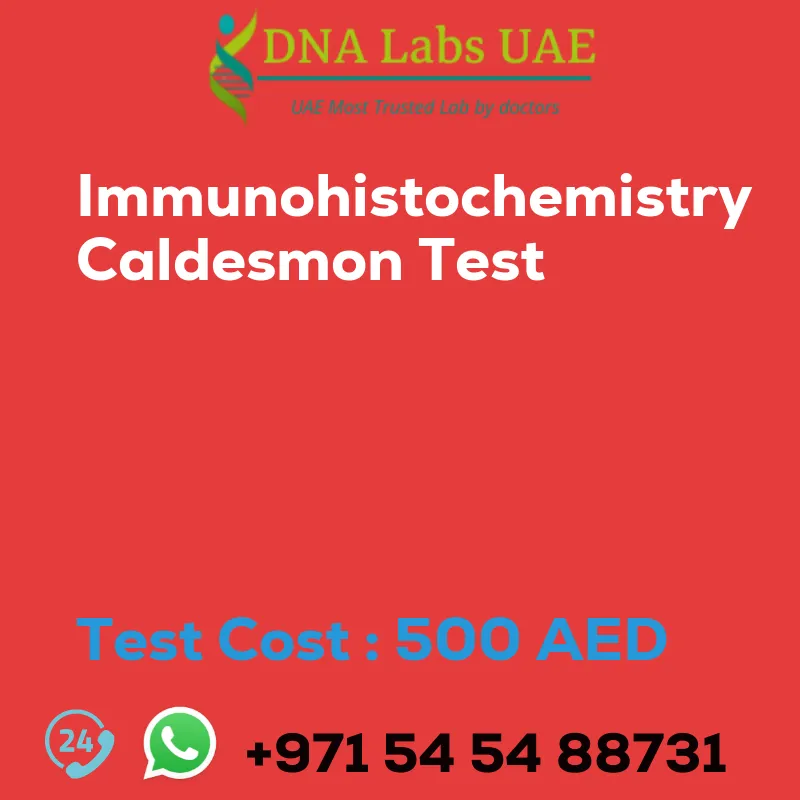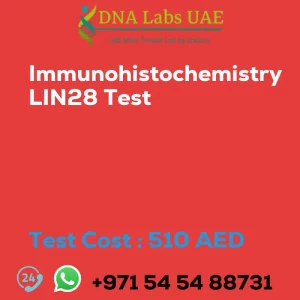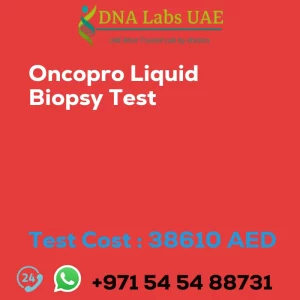IMMUNOHISTOCHEMISTRY CALDESMON Test
Test Name: IMMUNOHISTOCHEMISTRY CALDESMON Test
Components: Caldesmon antibody
Price: 500.0 AED
Sample Condition: Submit tumor tissue in 10% Formal-saline OR Formalin fixed paraffin embedded block. Ship at room temperature. Provide a copy of the Histopathology report, Site of biopsy and Clinical history.
Report Delivery: Sample Daily by 6 pm; Report Block: 5 days, Tissue Biopsy: 5 days, Tissue large complex: 7 days
Method: Immunohistochemistry
Test type: Cancer
Doctor: Oncologist, Pathologist
Test Department: DNA Labs UAE
Pre Test Information: Provide a copy of the Histopathology report, Site of biopsy and Clinical history.
Test Details
Immunohistochemistry (IHC) is a technique used in histology to detect and localize specific proteins within tissues using antibodies. The Caldesmon antibody is used in IHC to detect the presence and distribution of caldesmon in tissue samples.
The Caldesmon IHC test involves several steps:
- Tissue fixation: The tissue sample is first fixed using a chemical fixative such as formalin. This helps preserve the tissue structure and proteins.
- Tissue processing: The fixed tissue is then processed by embedding it in paraffin wax and sectioning it into thin slices (around 4-5 micrometers thick). The sections are mounted on glass slides.
- Deparaffinization: The paraffin wax is removed from the tissue sections by treating them with xylene or other organic solvents.
- Antigen retrieval: In order to expose the caldesmon protein for antibody binding, antigen retrieval is performed. This can be achieved by heat-induced epitope retrieval (HIER) or enzymatic digestion.
- Blocking: Non-specific binding sites on the tissue sections are blocked using a blocking agent, such as bovine serum albumin (BSA) or normal serum.
- Primary antibody incubation: The caldesmon primary antibody is then applied to the tissue sections and incubated overnight at a specific temperature. The primary antibody binds specifically to the caldesmon protein if present.
- Secondary antibody incubation: After washing away any unbound primary antibody, a secondary antibody conjugated to a detection molecule, such as a fluorescent dye or an enzyme, is applied to the tissue sections. This secondary antibody binds to the primary antibody, amplifying the signal.
- Visualization: If an enzyme-linked secondary antibody is used, a chromogenic substrate is added, resulting in the formation of a colored precipitate at the site of caldesmon protein. If a fluorescent secondary antibody is used, the tissue sections are directly visualized under a fluorescence microscope.
- Counterstaining and mounting: To enhance tissue contrast and provide structural information, the tissue sections may be counterstained with dyes such as hematoxylin. Finally, the slides are coverslipped using mounting media.
The results of the Caldesmon IHC test can then be interpreted by examining the stained tissue sections under a microscope. The presence and distribution of caldesmon protein can be assessed, providing information about the localization and expression levels of caldesmon in the tissue sample.
| Test Name | IMMUNOHISTOCHEMISTRY CALDESMON Test |
|---|---|
| Components | |
| Price | 500.0 AED |
| Sample Condition | Submit tumor tissue in 10% Formal-saline OR Formalin fixed paraffin embedded block. Ship at room temperature. Provide a copy of the Histopathology report, Site of biopsy and Clinical history. |
| Report Delivery | Sample Daily by 6 pm; Report Block : 5 days Tissue Biopsy : 5 days Tissue large complex : 7 days |
| Method | Immunohistochemistry |
| Test type | Cancer |
| Doctor | Oncologist, Pathologist |
| Test Department: | |
| Pre Test Information | Provide a copy of the Histopathology report, Site of biopsy and Clinical history. |
| Test Details |
Immunohistochemistry (IHC) is a technique used in histology to detect and localize specific proteins within tissues using antibodies. Caldesmon is a protein that is involved in regulating smooth muscle contraction. The Caldesmon antibody is used in IHC to detect the presence and distribution of caldesmon in tissue samples. The Caldesmon IHC test involves several steps: 1. Tissue fixation: The tissue sample is first fixed using a chemical fixative such as formalin. This helps preserve the tissue structure and proteins. 2. Tissue processing: The fixed tissue is then processed by embedding it in paraffin wax and sectioning it into thin slices (around 4-5 micrometers thick). The sections are mounted on glass slides. 3. Deparaffinization: The paraffin wax is removed from the tissue sections by treating them with xylene or other organic solvents. 4. Antigen retrieval: In order to expose the caldesmon protein for antibody binding, antigen retrieval is performed. This can be achieved by heat-induced epitope retrieval (HIER) or enzymatic digestion. 5. Blocking: Non-specific binding sites on the tissue sections are blocked using a blocking agent, such as bovine serum albumin (BSA) or normal serum. 6. Primary antibody incubation: The caldesmon primary antibody is then applied to the tissue sections and incubated overnight at a specific temperature. The primary antibody binds specifically to the caldesmon protein if present. 7. Secondary antibody incubation: After washing away any unbound primary antibody, a secondary antibody conjugated to a detection molecule, such as a fluorescent dye or an enzyme, is applied to the tissue sections. This secondary antibody binds to the primary antibody, amplifying the signal. 8. Visualization: If an enzyme-linked secondary antibody is used, a chromogenic substrate is added, resulting in the formation of a colored precipitate at the site of caldesmon protein. If a fluorescent secondary antibody is used, the tissue sections are directly visualized under a fluorescence microscope. 9. Counterstaining and mounting: To enhance tissue contrast and provide structural information, the tissue sections may be counterstained with dyes such as hematoxylin. Finally, the slides are coverslipped using mounting media. The results of the Caldesmon IHC test can then be interpreted by examining the stained tissue sections under a microscope. The presence and distribution of caldesmon protein can be assessed, providing information about the localization and expression levels of caldesmon in the tissue sample. |








